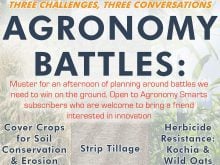Canadian farmers are facing some of the worst herbicide resistant weed conditions in the world, says a weed expert.
“Canada is probably number three in the world, as far as severity of problems,” said Ian Heap, lead organizer of the International Survey of Herbicide Resistant Weeds, a collaborative effort by 850 weed scientists.
“Wild oats and green foxtail, alone, would probably put you up there at number three in the world.”
However, Heap told producers at the Manitoba-North Dakota Zero Tillage Farmers Association’s annual workshop that Canadian producers are aware of the problem.
Read Also

VIDEO: Agritechnica Day 4: Robots and more robots, Nexat loves Canada and the trouble with tariffs
Agritechnica Day 4: Robots and more robots, Nexat loves Canada and the trouble with tariffs.
“Canada is really leading the world, even better than America, in actually acknowledging the problem,” he said. “Growers have actually taken notice.”
Heap, who researched resistance at the University of Manitoba and Oregon State University before starting a company that specializes in weed resistance, said 195 weed species are resistant to herbicides, including 114 broadleaf weeds and 81 grass weeds. They affect more than 500,000 farmers.
He said only the United States and Australia have more problems with herbicide resistance than Canada, although Argentina and Brazil are quickly catching up because of the millions of soybean acres in South America.
Hugh Beckie, an Agriculture Canada weed scientist in Saskatoon, agreed that green foxtail and wild oats are Western Canada’s biggest concerns.
Department surveys from 2008 show 55 percent of fields in Manitoba had wild oats resistant to Group 1 herbicides, 18 percent had wild oats resistant to Group 2 herbicides and 13 percent had wild oats with resistance to group 1 and 2.
As well, 44 percent of fields in Manitoba had resistant green foxtail in 2008, compared to 22 percent n 2002.
However, Beckie has found that tank mixing could slow the development of herbicide resistance in Western Canada.
In a study published in the July 2009 issue ofWeed Technology,he concluded that tank mixing works better than herbicide rotation in delaying resistance in field pennycress.
“What we found was that after four years (of trials), the mixture was effectively able to keep the resistance level at five percent, what we started with,” said Beckie, who also farms near Davidson, Sask.
In comparison, the number of resistant field pennycress seeds jumped from five to 29 percent after just one application of a Group 2 herbicide.
Heap said farmers are often reluctant to adopt such methods because of the short-term costs.
“It’s like anybody else. You look at making more money now, versus five or 10 years down the track,” he said.
“Whereas … if you do management strategies, you’ll buy yourself more time, but the payoff might be five or 10 years later.”
Heap said herbicide resistance is a massive problem around the world and will only get worse. However, with crisis comes opportunity and Heap believes chemical companies will find new modes of action.
“When Roundup Ready came out in 1996, a lot of the other companies … they thought the value had been taken out of the herbicide market … so they shut down their discovery programs,” he said.
“I’m hopeful that the companies are starting to gear up their discovery programs again.”
However, it will take time for those programs to pay off, he added.
“That is going to take a long time to come through the pipeline. It may take 10 or 15 years. So I see a major problem, short-term.”
TOP 10 HERBICIDERESISTANT SPECIES
•Rigid ryegrass, Lolium rigidum
•Wild oats, Avena fatua
•Redroot pigweed, Amaranthus retroflexus
•Common lambsquarters, Chenopodium album
•Green foxtail, Setaria viridis
•Barnyardgrass, Echinochloa crusgalli
•Goosegrass, eleusine indica
•Kochia, Kochia scoparia
•Horseweed, Conyza canadensis
•Smooth pigweed, Amaranthus hybridus















